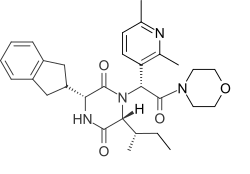Epelsiban
 | |
| Clinical data | |
|---|---|
| ATC code |
|
| Legal status | |
| Legal status |
|
| Identifiers | |
| |
JSmol) | |
| |
| |
Epelsiban (
Discovery and Design
Screening the GSK compound collection and various libraries identified

The (3R, 6R, 7R) series 2, 3 showed very good levels of selectivity relative to the
Mechanism of action
In-vitro binding inhibition data showed that Epelsiban is a highly potent and selective non-peptide oxytocin antagonist with sub-namomolar potency at the human oxytocin receptor (hOTR) Ki = 0.13 nM and with>50000-fold, >63000-fold, and >31000-fold selectivity over the human V1a, V1b and V2 vasopressin receptors. It is also 100-fold more potent at the hOTR than atosiban (a marketed intravenous peptide oxytocin antagonist) and is 5-fold more potent against the hOTR, and more selective against the human vasopressin receptors, especially V2, than retosiban. High in vivo oxytocin antagonist potency was demonstrated in the anesthetized rat model, where uterine contractions were elicited by intravenous administration of oxytocin and reduction in uterine contractility was measured after subsequent intravenous administrations of increasing doses of Epelsiban, which gave an IC50 of 192nM.
Pharmacokinetics
Epelsiban has a good Cyp450 profile with no significant inhibition IC50 > 100μM together with no time-dependent inhibition observed against the five Cyp450
Pharmacology
Epelsiban was investigated for a potential role in benign prostatic hyperplasia also called prostate enlargement.[9] Oxytocin treatment induces prostate enlargement in mice and produces contractions of the prostate through its specific receptor.[10] Oxytocin concentrations are elevated in prostatic tissue from patients with benign prostatic hyperplasia. Epelsiban was found to inhibit the contractile effect of oxytocin in human prostatic tissue through its specific oxytocin receptors in a concentration-dependent manner.[9] suggesting a potential role in the treatment of benign prostatic hyperplasia. The selective antagonist Epelsiban was designed to work on peripheral human oxytocin receptors and not to readily pass the blood–brain barrier.[4] However Epelsiban was found to inhibited brain oxytocin receptors mediating ejaculation, when given intraventricularly to rodents.[5] As expected, despite this success achieved in mice, oral epelsiban in humans at 50 or 150 mg has not shown satisfactory results in a double blind, placebo-controlled trial.[6] This suggested that a central nervous system (CNS) penetrant oxytocin receptor antagonist would show an effect on ejaculation when given systemically. This has been achieved with the Cligosiban which has good CNS penetration.[11] Epelsiban was also investigated as an agent to enhance embryo or blastocyst implantation in women undergoing embryo or blastocyst transfer associated with in vitro fertilization (IVF).[7] and for use in the treatment of adenomyosis.[8] However the development of epelsiban for adenomyosis was terminated in December 2016 for strategic reasons and not because of any safety concerns.
Synthesis
The cyclic dipeptide Epelsiban is formed by cyclizing the corresponding linear dipeptide. In the highly

History
In screening the GSK compound collection and various libraries, a key consideration was to choose a template with good levels of selectivity over the three vasopressin receptors which are structurally similar to the oxytocin receptor. In addition all templates were also assessed by
See also
References
- ^ "International Nonproprietary Names for Pharmaceutical Substances (INN). Recommended International Nonproprietary Names (Rec. INN): List 67" (PDF). World Health Organization. p. 62. Archived from the original (PDF) on October 5, 2016. Retrieved 4 October 2016.
- ^ USAN Council (2011). "Statement on a Nonproprietary Name Adopted by the USAN Council" (PDF). Retrieved 2011-10-28.
- ^ PMID 22239250.
- ^ ISBN 978-3-527-33107-9.
- ^ PMID 23530818.
- ^ PMID 23937679.
- ^ S2CID 23903528.
- ^ S2CID 41083332.
- ^ .
- PMID 28130436.
- PMID 30527053.
